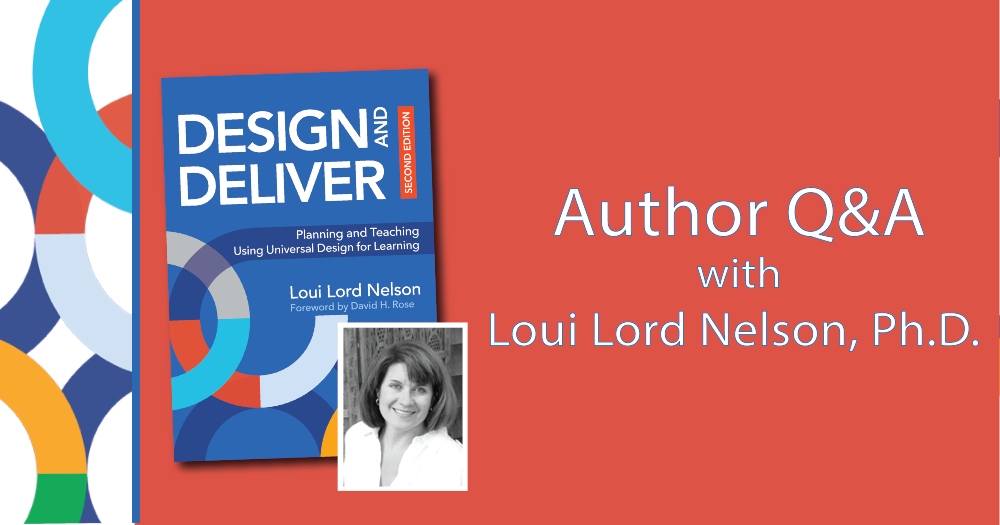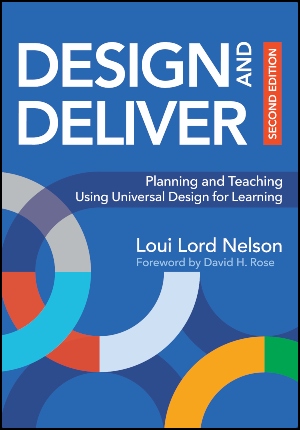Author Q&A with Loui Lord Nelson on the new Design and Deliver

Universal Design for Learning (UDL) is the premier educational framework for making learning accessible to all, and since 2014, Loui Lord Nelson’s engagingly written and research-based Design and Deliver has been the go-to UDL primer for busy teachers looking to consistently promote better outcomes for every learner. With the release of the eagerly anticipated second edition of Design and Deliver just days away, we asked Dr. Nelson to join us for a short Q&A covering the most valuable new additions to the book, what she would say to teachers who are hesitant to start their UDL journeys during turbulent times, and more.
1. Your first edition of Design and Deliver was a landmark UDL resource, and we couldn’t be more excited about the new edition. What would you say are the most valuable additions and updates you’ve made to the book this time around?
Thank you. I have been amazed and honored by the response to the first edition. When I began designing the second edition, I knew I wanted it to be more interactive and conversational. There was the obvious part of identifying research that had come out since 2013-–2014, but I wanted to create a voice that invited the reader in and kept them interested. UDL has significant depth, and I hope to encourage educators to dive into it with excitement and wonder. I knew I needed to provide that scaffolding in a variety of ways.
As for specific content, I was happy to tuck in question sets throughout the chapters and activities at the end of the chapters that I’ve used in trainings over the years. In retrospect, everything in the book has been applied in some form with educators across the world. I kept and improved on the activities based on feedback and some of those ended up in this edition.
2. How did the realities of the COVID-19 pandemic affect your process as you worked on the new edition of Design and Deliver? Was the new information about online learning directly inspired by the pandemic, or had you already planned to include more on virtual instruction?
Oh, COVID-19 has thrown us all through a loop! From the migration of face-to-face to digital learning to hybrid settings and back again (in some cases), it has tossed the lives of all educators around. I’ve had the analogy of a rock tumbler in my head for a while. People who are rock hounds collect all sorts of rocks and want to polish them, so they put them into a tumbler which has the same motion as a standard clothes drier. The rocks tumble around with some abrasive grit and water. That sounds aggressive and painful, but the rocks come out beautifully polished. In my head, we’re all rocks. The grit and the water are everything we’ve been tumbling through. My hope is to come out more polished after months of being tumbled.
Part of that polish comes from continued learning, which is what the process of this revised edition gave me. I spent time searching for, reading, listening to, reflecting on, digesting, and assimilating the updated research behind the guidelines as well as the entire framework. I loved it. Honestly, Design and Deliver was part of my COVID-19 stay-sane plan.
As for the technology tips, I actually had the idea for them at the very beginning of 2020. I had started to play around with the idea, but the pandemic definitely made the idea more relevant and important. Even more important was framing the tips so readers understood that all decisions, including what technology to use in the classroom, should be guided by the framework and the curriculum. Curriculum, in the UDL sphere, is made up of the goals, methods, materials, and assessment. The goal should drive the other three areas, which means the goal should drive what technology you’re making available to the students and how you envision them using it. When you understand what your students need to achieve, you can offer the right technology to support that journey. My goal was to offer technology tips that helped educators find that line of thinking and stick with it.
3. Can you talk a little about the online materials that accompany the book? What have you included to help educators design instruction using UDL principles?
Online materials are always a little risky to put in a print book. Links to digital resources shift pretty rapidly, so my focus was to identify (a) resources that have been stable over time, or (b) resources I controlled. Based on the latter, the most frequently used online resources are interviews from my podcast, UDL in 15 Minutes. I interview educators from around the world about their implementation of UDL. Each story is unique and each story is rich because teachers are the best storytellers. And because the number of podcast episodes will continue to grow, readers will always have new content.
Other online materials include links to specific spots in websites (e.g., within the CAST website). My hope is to get the readers into certain sites so they get to know them and see them as a resource. If Design and Deliver can be a springboard to the work of others, that will make me extremely happy.
Companion Materials
Designing instruction with UDL is easier than ever with these online resources, available as printable downloads, that come with your purchase of the new Design and Deliver: CAST UDL Guidelines; an Identifying Your Resources chart; a UDL design cycle graphic; a UDL lesson plan flowchart; and classroom resource mapping charts for elementary, middle, and high school teachers.
4. Teachers who are new to UDL may be intimidated by the thought of starting their UDL journey in this turbulent time period, when remote or hybrid learning is complicating the way we teach and learn. What would you say to teachers who fear it isn’t the “right time” to start exploring and embracing UDL?
Learning anything that is new takes energy. Many educators, if not most, are exhausted right now because they have spent a great deal of energy learning how to teach in a completely different context. And that context hasn’t stayed the same for many teachers. Most shifted to full online teaching, some shifted back to some form of face-to-face, and some switch between the two. That has turned planning and teaching on its ear. That said, I love efficiency. I love identifying a system that helps me make effective decisions in the moment. We all need efficiency right now and I believe the UDL framework provides that.
Before diving into the graphic organizer (also referred to as The Guidelines), I suggest educators learn about variability. This concept, which comes from the neurosciences, tells us that all learners learn differently and every learner learns differently based on the context. For example, a learner might do well in one context (e.g., digital), but might not perform as well on the same material when in another context (e.g., face to face). That child is demonstrating their variability.
In conjunction with variability, I like to introduce the concept of expert learning. This is an understanding that learning goes beyond memorization and even creativity (e.g., Bloom’s Taxonomy). Expert learners guide their connection to learning, they understand how to use what is around them to gain the knowledge they seek, and they understand how to set themselves up for successful learning. They don’t start there, though. They need experiences, feedback, and guidance to help them grow. Those experiences are woven throughout the UDL guidelines and checkpoints.
After that, it does not matter where someone starts. I always like the top row of the current UDL graphic which has the guidelines of Recruiting Interest, Perception, and Physical Action across the top. I call those the “welcome mat.” Educators who use these guidelines to make instructional decisions are much more likely to create an inclusive space that welcomes all learners. By using these guidelines as a tool for decision-making, you’re planning for variability up front. Each checkpoint makes you think more deeply and holistically about all of your learners across contexts from the get-go, saving time on the backend.
5. In your new edition, you share brief anecdotes from teachers who have successfully applied a UDL lens to their lesson planning. Can you share one of your favorite UDL success stories?
Like it or not, I’m not one to have favorites. Instead, I like to think about the patterns of success I see. Those patterns include innate curiosity, a desire to learn, apply, reflect, and shift, and strong skills in communication. These individuals recognize positive shifts in practice and enjoy talking about them and sharing them.
I’ve been in education long enough to hear about the “pendulum.” For example, my elementary program provided Individually Guided Education. There was a heavy focus on student-led learning and choice, cross-subject units, and goal-setting. Much of that is woven into UDL, so it would be easy to say that the pendulum has swung back. But that isn’t right. A pendulum is linear—it moves back and forth. The vastness of research that impacts education does not create a linear pattern. Just the field of neuroscience, a foundational component of UDL, is multi-faceted. Growth is more like an expanding sphere, pushing out in all directions, building on the old and occasionally pulling some of that with it, but also leaving a lot of it behind because of new findings.
Whether they are in the classroom, leading a school, or leading a district, when I see educators who allow their curiosity to propel them into learning—and follow that with the risk-taking of application, reflection on that risk-taking, and then shifting their practice—I know they are going to embrace UDL. I also know they will want to share the framework with others and find ways to send others down that path. These are the innovators who create rich learning environments for students and colleagues. These are the educators who truly change lives. If you read the different anecdotes throughout the book, you will see these characteristics in each of those educators. That’s why I can’t identify a favorite. They are all life changers.
Interested in learning more?
Design and Deliver
Planning and Teaching Using Universal Design for Learning, Second Edition
Universal Design for Learning (UDL) is the best way to teach all students effectively and break down barriers to learning—but how can busy teachers get started with UDL right now? Find the answers in the second edition of this bestselling, teacher-trusted primer, created by internationally recognized UDL expert Loui Lord Nelson.
More Resources
- Read a free excerpt from the book. Chapter 1: Introducing Universal Design for Learning
- Discover what’s new. Download this handout for a quick look.
- Read a guest blog post by Loui Lord Nelson. UDL and Self-Regulation During Distance Learning


